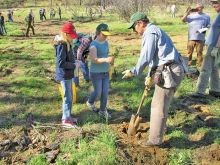Plan for replanting: Environmental, timber leaders hope to move project forward
| By Alex MacLean, The Union Democrat December 03, 2015 01:00 am Tuolumne County elementary school students in March helped plant seedlings in the Groveland Ranger District (above). Courtesy photo / Stanislaus National Forest Service. More than two years since the 2013 Rim Fire, the Stanislaus National Forest is seeking input on a proposed plan to replant trees across 21,300 acres that burned in the historic blaze. Timber industry and environmental leaders in Tuolumne County who disagree over some aspects of the plan are hoping to work together in the coming months on a compromise that would keep the project moving forward. “I think you’ll find agreement from everybody here that something needs to be done out there and needs to be done quickly,” said logger Mike Albrecht, who owns Sierra Resource Management in Jamestown and stays active in issues affecting the local timber industry. The Rim Fire consumed more than 257,000 acres in the Central Sierra region from August to October 2013, including about 154,000 acres in the Stanislaus National Forest. Some areas burned so severely that little to nothing survived plantwise. Much of the service’s proposed reforestation plan calls for replanting in the high-severity burn areas where natural regrowth would be unlikely due to the lack of standing trees. “A lot of the (Rim Fire area) wasn’t forested to begin with, including the canyons,” said Maria Benech, who is leading the service’s reforestation project. “The areas we’re really focusing on are the high-intensity burn areas where most or all of the trees were killed, and natural regeneration is improbable because there’s no seed source.” The recently unveiled plan is a scaled-down version of an earlier proposal to replant about 30,000 acres. Benech said the scope was reduced because about 4,000 acres previously targeted will be managed for deer habitat, while another 4,000 may grow back naturally. All planting is scheduled to occur over a period of roughly six to seven years, Benech said. Professional crews that can plant about 1,000 to 1,200 trees per day would be contracted to do the work, while about 200 acres would be planted by volunteers. “We’ll be doing all of this by hand,” Benech said. “The ground out there isn’t really conducive to machine planting.” Roughly 7 million saplings would be needed to replant the whole area, Benech estimated. Most would likely come from the service’s nursery in Placerville from locally gathered seed. Much of the area would be reforested with ponderosa pine, though incense cedar, sugar pine, douglas fir, white fir and giant sequoia may also be used. The plan calls for using the herbicide glyphosate to kill brush that could otherwise prevent the conifer saplings from maturing. Benech said one alternative outlined in the plan would use no herbicide, but it would likely be costly because the brush would need to be removed by hand or machine. Completely foregoing the use of herbicides would also reduce the survival rate of saplings from 75 to 50 percent, she added. John Buckley, of the Central Sierra Environmental Resource Center in Twain Harte, took issue with the amount of herbicide proposed, saying it could prove controversial. Glyphosate, the most widely used herbicide in the world, was recently linked to cancer by the World Health Organization. “By reducing the level of controversy, our center believes we can get the reforestation going without the chance of lawsuits from outside forces,” he said. “Look for areas that are least controversial for planting and use herbicides when needed, but minimize the overall amount.” Buckley also criticized the plan’s call for replanting more than 400 trees per acre in some areas, arguing that 100 to 150 trees per acre would create a healthier and more fire-resilient forest. Albrecht, on the other hand, supports the use of herbicides and feels a “fair number” of trees should be replanted to ensure that the forest regrows. Despite the disagreements on the approach, there’s hope for both sides to reach some sort of compromise that would prevent the project from getting derailed. “Our center is supportive of getting the reforestation going,” Buckley said. “We think there’s a middle ground that people with many different points of view can agree is balanced.” Albrecht and Buckley serve as co-chairmen of Yosemite Stanislaus Solutions, a collaborative group of timber industry and environmental leaders. The group previously worked with Forest Service officials to craft a logging project across more than 30,000 acres in the Rim Fire area that successfully withstood lawsuits aimed at stopping it from outside environmental organizations. Both say they agree that the post-fire logging and proposed reforestation are necessary to help restore the forest for wildlife habitat, recreation and economic opportunities. “Choosing a no-action alternative would lead to tens of thousands of acres of brush fields and dead trees just falling over and piling on top of each other,” Albrecht said. “It would not only create a tremendous fire hazard, but change the look of the forest for many generation |
Recent Press & News
- Local Forest Health Project Receives $6.9-Million In Funding April 11, 2024
- Tribe and Others Receive Funding March 13, 2024
- The Smokey Wire : National Forest News and Views TSW Exclusive: A Tale of Two SERALs- Making Landscape Scale Resilience Happen With the Stanislaus Forest and YSS February 29, 2024
- Planting Trees to Replenish Forest in the Rim Scar February 29, 2024
- Stanislaus National Forest Awarded $57.6M in Wildfire Crisis Strategy Landscape FY24 Funding January 17, 2024
- 20-year study confirms prescribed burning, forest thinning reduce risks of catastrophic wildfire January 11, 2024
- Fuels Storyboard Shows Investment in Wildfire Resiliency December 7, 2023
- New project more than doubles size of fire reduction work in Stanislaus National Forest November 30, 2023
- A decade later, lessons from Rim Fire August 19, 2023
- $3.7 Million Approved For Forestry Efforts In Tuolumne County August 16, 2023

